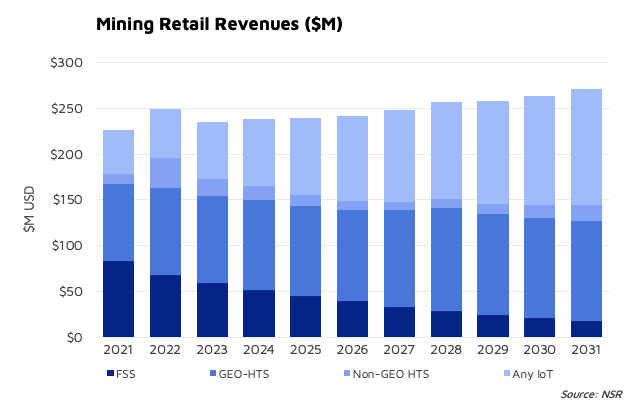Satcom for Smart Mines
In today’s energy world, there is a growing need for resilient, high-speed connectivity that can seamlessly support everything from exploration and upstream scouting to extraction and distribution. Energy companies and remote operations worldwide are looking to improve productivity, crew well-being, and site safety with real-time video streaming, continuous communications, and advanced analytics. Demand for reliable, high-speed connectivity is at an all-time high.
The energy industry is progressively deploying Internet of Things (IoT) solutions to conduct operations more productively and lower costs. According to NSR’s latest edition of the Energy SATCOM Markets (ESM9) report, IoT and NGEO are key enabling SATCOM technologies helping to drive more than $15 Billion in Retail Revenues across Oil & Gas, Mining, and Utilities sectors.

The mining industry is moving in a new digital direction as it begins to embrace new processes through automation and digitalization, increasing remote control and proactive remote maintenance of assets. Advanced connectivity will optimize drilling and production throughput and improve maintenance and field operations. In the mining industry, IoT is used as a means of achieving cost and productivity optimization, improving safety measures, and developing their artificial intelligence needs. The mining industry helps the world in meeting the most basic demands for energy and livelihood. It further provides raw material to oil, energy, agrochemicals, and synthetic fabrics industries. It is essential to offer cost optimized production while maintaining the quality. In order to fulfil the requirements, IoT comes to rescue. Applications include improving performance and productivity thereby eliminating unnecessary costs, anticipating machine failure and optimization of machinery and plants.
The mining industry often requires rapid innovations, technologies, automation, digitization and electrification. From NSR’s ESM9 report “IoT growth will nearly 3x revenues from 2021 vs. 2031, helping to ultimately growth topline figures. For service providers and satellite operators focused on the sector, reliability or cost are the two big driving considerations for end-users. Usually, it doesn’t happen at the same time.” Service revenues will remain relatively constant throughout the forecast period, growing at a CAGR of 1% with a cumulative revenue of $2.4 billion.
Communications requirements at remote sites are rapidly increasing. The need for real-time data exchange is critical to operations providing the information, connectivity and control that management requires. Extending a high-speed network or Virtual Private Network (VPN) enables file sharing, video or similar broadband services. As the demand grows for more advanced substation automation applications, so does the demand for greater bandwidth requirements for remote sites.
While the launch of 5G has resulted in significant increases in coverage and reliability of connectivity, particularly with the introduction of remote pico-style towers and other smart mining technologies, connectivity is an issue that’s in clear focus for the IoT industry. But as the issue diminishes and new connectivity options like low-latency satellite communications open up, poor cybersecurity is likely to be the key issue delaying IoT adoption.
The Bottom Line
Smart mines are paving the way of the future, and they provide numerous advantages. IoT is the backbone of the mining industry as it provides all the relevant technologies and facilities. The benefits of mining IoT applications lie in delivering value through an integrated deployment approach. IoT will enable the sector to digitize, optimize, and automate hitherto disconnected activities, saving time, and money, and enhancing safety.
